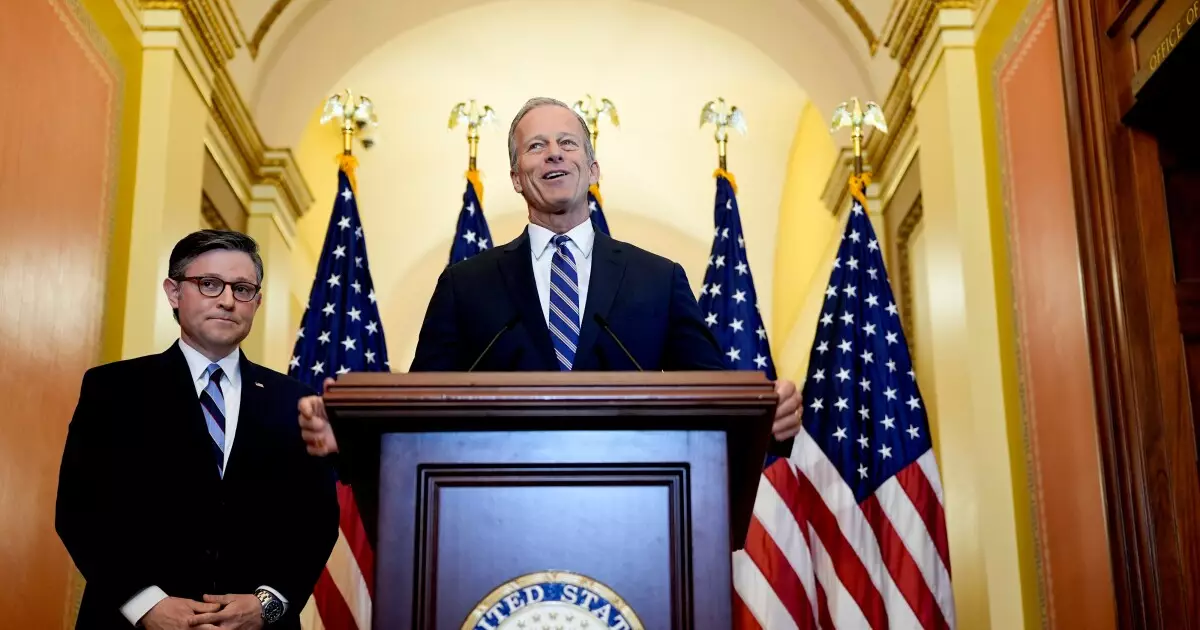The recent passage of President Donald Trump’s “big beautiful bill” in the House of Representatives, with a razor-thin margin of 216-214, serves as both a clarion call and a cautionary tale for fiscal conservatives. While Republican leaders managed to corral a handful of dissenters, this legislation—which is poised to stretch the nation’s budget by an estimated $5 trillion—raises serious questions regarding the efficacy and sustainability of its proposed measures. It’s a victory soaked in ambiguities, as the promise of deep spending cuts appears more optimistic than realistic and invites skepticism regarding the genuine intent of reform.
The House Speaker, Mike Johnson, and Senate Majority Leader John Thune are attempting to paint a rosy picture, positioning the budget resolution as a significant step towards a reconciliation bill that ostensibly aligns with Trump’s market-friendly agenda. However, even the staunchest conservative lawmakers are voicing concerns. Skepticism abounds, especially considering the rhetoric around “aiming higher” for cuts when it remains unclear how—or if—they will genuinely benefit the average American taxpayer.
Illusory Cuts and Tax Reduction Fantasies
One of the most glaring flaws in this proposal lies in its declared intention to slash at least $1.5 trillion in federal spending. While on the surface, this seems economically prudent, wary observers note that the cuts come with a caveat: the relationship between spending cuts and tax cuts appears overly optimistic. There’s maneuvering involved that may lead to increased taxation elsewhere, which could affect the municipal bond market and, ultimately, the very citizens they claim to support.
Furthermore, the distinction in policy approaches between the House’s proposed budget and the Senate’s current policy baseline model is eerie. The vagueness of financial projections allows lawmakers to sidestep the difficult conversations regarding how to offset the extension of the Tax Cuts and Jobs Act (TCJA). More disturbingly, the notion of “current policy” can be a convenient way to obscure the true fiscal health of the nation’s budget.
The Math Doesn’t Add Up
Both the House and Senate proposals hint at tax cuts potentially amounting to a staggering $4 trillion—numbers that would make any rational budget analyst cringe. Promises of tax relief for the middle class, combined with monumental deficits, paint a dismal financial picture. The sole dissenting votes from Rep. Thomas Massie and Rep. Victoria Spartz remind us that not all Republicans are willing to turn a blind eye to fiscal responsibility.
The idea that cutbacks over the next decade will somehow counterbalance the impending losses from these tax cuts is unrealistic at best and disingenuous at worst. This strategy risks cultivating an environment where spending is not truly curtailed but rather shuffled, allowing the government to continue its actions under the guise of fiscal responsibility. The larger deficits projected could only exacerbate existing economic inequalities, creating a fertile ground for disillusionment among voters.
Changing the Rules of Engagement
One alarming tactic that has emerged during these negotiations is the adjustment of accounting rules—an action Rep. Spartz labeled as “opening up a Pandora’s box.” This change is a troubling sign that legislators may be prioritizing political expediency over long-term fiscal health. By manipulating financial parameters to mask deficit growth, they are not only jeopardizing trust with constituents but also leading the nation down a troubling path of governance by illusion rather than realistic reform.
This trend raises an essential ethical question: Is this budget plan genuinely aimed at improving the fiscal health of America, or is it simply strategic smoke and mirrors to placate disenchanted conservatives while preserving the status quo? The ambiguity could result in a backlash from voters who are growing weary of political doublespeak and unfulfilled promises.
In the public sphere, discussions surrounding governmental finances must prioritize transparency and accountability. Simplistic promises of tax cuts and spending trims can entrap the American populace into supporting initiatives that ultimately fail to deliver substantial improvements in their everyday lives. As we navigate this convoluted fiscal landscape, it is crucial to remember that reality must supersede rhetoric.
While the passage of Trump’s latest spending bill may appear as a political win for certain factions, it must be scrutinized to ensure our financial future remains intact—lest we sacrifice economic stability for political gain.

